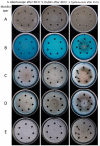Identification and phase inversion of Salmonella flagellar antigens, using immuno-discs
- PMID: 29415900
- PMCID: PMC5880822
- DOI: 10.1292/jvms.17-0122
Identification and phase inversion of Salmonella flagellar antigens, using immuno-discs
Abstract
Disc immuno-immobilization is a simple method for typing the flagellar phase of Salmonella enterica. We re-examined this method using commercial antisera, which contains the preservative sodium azide. Originally prepared motility agar activates bacterial motility and renders S. enterica resistant to sodium azide, resulting in the formation of immuno-immobilization lines around reactive immuno-discs. Though disc immuno-immobilization serves both serotyping and phase inversion, this method is insufficient for the strains in which phase variation rarely occurs. Here, we devised a novel immuno-disc phase inversion method, and all S. enterica strains tested were identically typed. These methods would drastically simplify the task of S. enterica typing in clinical laboratories.
Keywords: Salmonella enterica; flagellar antigen; immuno-disc.
Figures




Similar articles
-
Identification of Escherichia coli flagellar antigen by disc immuno-immobilization.J Gen Appl Microbiol. 2025 Jul 15;70(5). doi: 10.2323/jgam.2025.04.001. Epub 2025 Apr 23. J Gen Appl Microbiol. 2025. PMID: 40268391
-
Disc immuno-immobilization method for simultaneous typing and isolation of Salmonella flagellar phases.J Bacteriol. 1968 Jul;96(1):160-4. doi: 10.1128/jb.96.1.160-164.1968. J Bacteriol. 1968. PMID: 4874303 Free PMC article.
-
Immunomagnetic separation for enhanced flagellar antigen phase inversion in salmonella.Lett Appl Microbiol. 1997 Mar;24(3):217-20. doi: 10.1046/j.1472-765x.1997.00390.x. Lett Appl Microbiol. 1997. PMID: 9080704
-
[Salmonella multiphasic flagellar antigen].Postepy Hig Med Dosw (Online). 2012 Jun 26;66:446-51. doi: 10.5604/17322693.1001631. Postepy Hig Med Dosw (Online). 2012. PMID: 22922144 Review. Polish.
-
[Flagellar antigen of Salmonella (author's transl) ].Tanpakushitsu Kakusan Koso. 1974 Sep 17;19(10):783-93. Tanpakushitsu Kakusan Koso. 1974. PMID: 4140544 Review. Japanese. No abstract available.
References
MeSH terms
Substances
LinkOut - more resources
Full Text Sources
Other Literature Sources
Molecular Biology Databases

